Ready to get started with cardio but don’t know where to start? These beginner-friendly cardio workouts will help you burn more calories and kickstart your fitness goals.
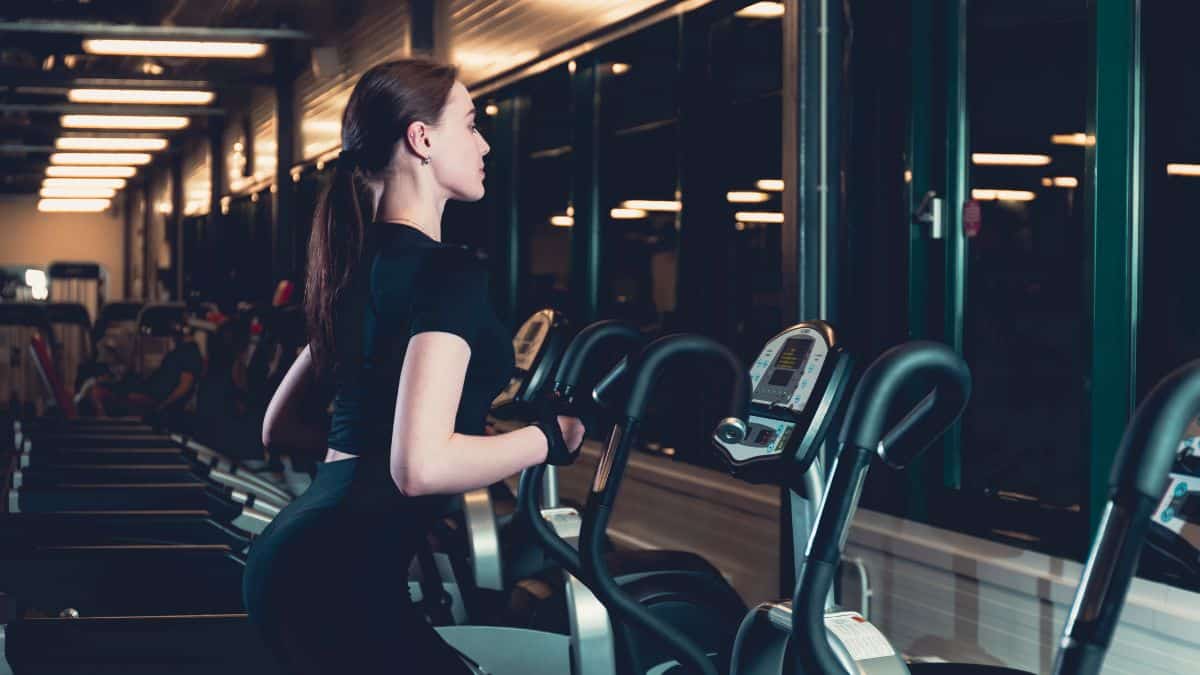
Cardio is a crucial part of any workout program, regardless of what your goals are in the gym.
Not only does it help to expand your cardiovascular capacity (enabling your heart and lungs to function better), but it translates into better functional fitness—aka, easier performance of your everyday activities.
No matter what your fitness goals, you need to incorporate at least some cardio training into your weekly routine.
It will be absolutely game-changing for your fat-burning and weight loss, and make you a fitter, healthier person overall.
In this article, we’ll look at everything a beginner needs to know about cardio, including what it is, what machines you should be using for your workouts, and more. I’ll even share with you a few of my all-time favorite—and most effective—cardio workouts to try at home or at the gym.
By the end of this post, you’ll be ready to incorporate cardio into your weekly workouts starting today!
Cardiovascular Exercise – Overview
Let’s start off with the basics: what is cardio and how is it good for you?
When we use the term “cardio” in this context, we’re referring to “cardiovascular exercise”, which means any exercise that improves your cardiovascular endurance.
Cardiovascular endurance refers to a number of internal functions:
- Your lungs’ ability to absorb oxygen through the air you breathe and infuse it into your bloodstream
- Your heart’s ability to increase blood flow of that oxygenated and nutrient-rich blood to the muscles and body parts that are working during exercise
- Your blood vessels’ ability to dilate for more blood to flow
Cardiovascular exercise focuses chiefly on these factors. Rather than engaging muscles singly, cardio engages all or many of the muscles (such as your legs when running, or your upper and lower body when rowing) to increase the energy demands on your cardiovascular system.
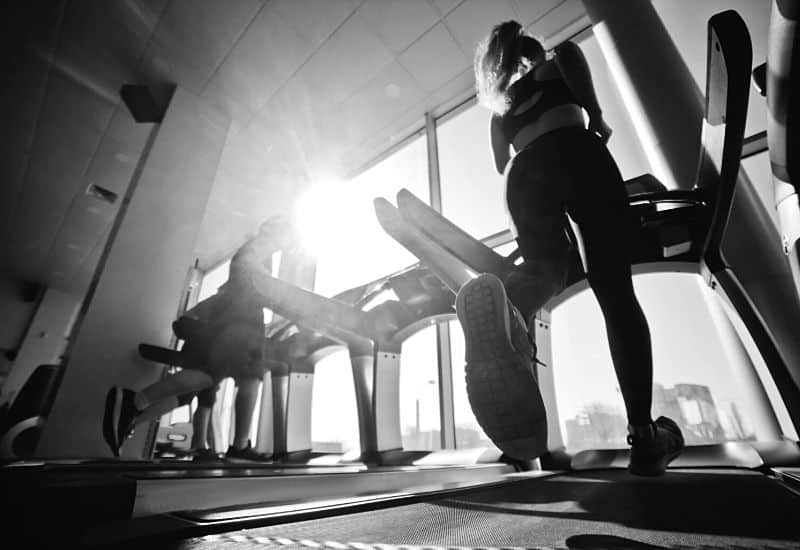
This increased demand forces your body to work harder to produce and distribute energy, which in turn requires your cardiovascular system to act as the “delivery man” for that energy.
The benefits of cardio1 are many, indeed:
- Encourages weight loss, specifically the burning of excess body fat as energy
- Protects your immune system and makes you more resistant to illness
- Increases your stamina for active activities of daily life
- Improves your overall fitness and endurance
- Decreases your risk of obesity, Type 2 diabetes, stroke, heart attack, and other illness
- Strengthens your heart muscle
- Enables your blood vessels to dilate (expand) effectively, preventing blockages that could lead to heart attacks or strokes
- Lowers the risk of osteoporosis (a positive effect of high-impact cardio)
- Protects your cognitive function as you age, keeps your mind sharp
- Encourages a longer lifespan
- Improves your mood, combats depression, and raises your self-esteem
All of these are pretty great reasons to incorporate cardio into your weekly training sessions!
What Machines Should Beginners Use for Cardio?
There are plenty of ways you can get good cardio exercise on your own. For example, take a walk, go for a run, paddle a boat, climb stairs, hike in the forest, or swim in rivers, lakes, or the ocean. Really, any exercise that gets your heart pumping and your body moving will give you some form of cardio.
However, for those who are serious about doing concentrated, high-quality cardio training, it’s often a good idea to work with machines in the gym (or at home) that allow you to focus on your cardio.
When at the gym or training at home, here are the best machines beginners should be using for cardio:
Treadmill
The treadmill simulates walking, jogging, and running, either on flat ground or on an incline. However, because it’s indoors, you can walk, jog, or run all year-around, even during the wet, snowy, and cold days when you can’t run outside.
Jogging and running are excellent forms of cardio, and one of the most “functional” forms of exercise you can do.
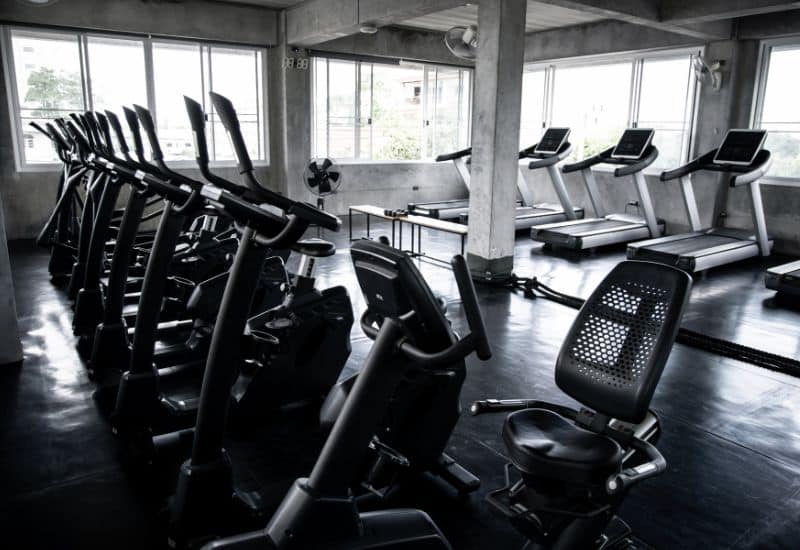
After all, improving your ability to run around means you can travel on foot more easily and without tiring as often. Even just walking for longer periods (upwards of 1 hour) will make getting around town or exploring a new city on holiday exponentially easier.
Rowing Machine
The rowing machine is one of my personal favorite machines because it delivers a full-body workout and is a lot more fun than most of the other cardio machines in the gym.
With the rowing machine, you’re simulating the movement of rowing a boat (gripping a pair of oars), and the repeated movement does wonders to strengthen your arms, shoulders, upper back, core, and legs.
See also: 10 Benefits of Rowing Machines (Plus Two Disadvantages)
Spending even just 30 minutes on the rowing machine can be an amazing workout that will burn a lot of calories and improve your cardiovascular conditioning significantly.
Elliptical Machine
When it comes to “most effective cardio machine in the gym”, the elliptical machine takes the title with ease.
No other machine in the gym can activate as many muscles as the elliptical, meaning no other machine can match it for energy-burning (put simply, the more muscles need energy supplied, the harder your cardiovascular system has to work to deliver that energy).
The elliptical trains your legs, arms, shoulders, chest, back, and core, even working your forearms! You can easily use it for a wide range of workouts—from HIIT to leg-focused to stair-climbing to low-intensity—all of which will deliver the calorie-burning results you want.
It’s also one of the safest machines in the gym, with minimal impact on your joints, making it incredibly easy for those who are dealing with existing knee, back, hip, ankle, wrist, or elbow problems.
Stair Climber
The stair climber is another great cardio machine to use because of how difficult climbing stairs can be! Your legs have to push off the lower stair and propel you upward, meaning your quads, calves, and glutes all get quite the effective workout.
But because of how much effort is required to push upward (rather than just walking straight forward on level ground), stair-climbing burns calories almost on par with elliptical training or jogging.
Granted, stair-climbing is definitely harder on your knees, and it’s difficult to sustain the exertion for very long periods of time (1+ hour). However, for a shorter, higher-intensity workout, it can be a truly amazing calorie-burner!
Beginner Cardio Workouts
If your goal is to get in more cardio, below I’ve included three highly effective workouts that you’ll be glad to know are totally suited to beginners.
They use three of my favorite machines and will help you to push your cardiovascular system to its limits, all while delivering effective fat-burning results.
Workout #1: Treadmill HIIT Session
This workout calls for you to use the treadmill. If you’re new to the treadmill, it’s worth taking a bit of time to get accustomed to the way the machine feels, as well as keeping your balance and staying centered on the machine.
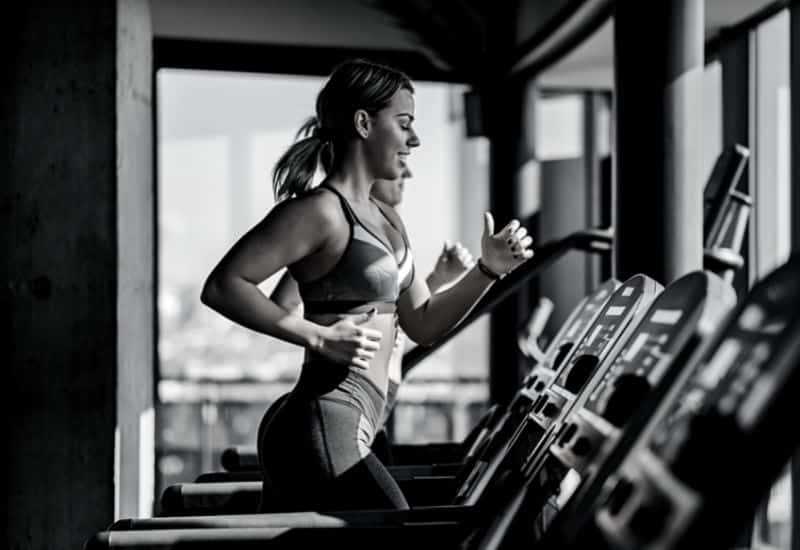
Because once we speed things up, you’ll need to be ready to run hard without risking injury.
The workout is actually a fairly simple and time-efficient one:
10 Minutes of Warm-Up – Spend 2 minutes walking at a slow pace (usually 3.2 MPH is a good start), then spend the remaining 8 minutes at a faster pace (between 3.6 and 3.9 MPH). The goal isn’t to start burning energy yet, just get your body warm, your muscles moving, and your cardiovascular system ready to work.
20 Minutes of 2-Minute intervals – When your warm-up is complete, raise the speed on the treadmill to a fast run (usually in the 7.5-8.5 MPH range). Hold this “sprint” pace for 30 seconds, then drop it back down to a fast walk (around 3.8 MPH). Walk for 90 seconds, then switch back to the 30-second sprint. Repeat this cycle (30 seconds fast and 90 seconds slow) 10 times, for 20 minutes total.
10 Minutes of Cool-Down – For the first 5 minutes, walk at a moderate pace (around 3.5 MPH) to give your body a chance to slowly cool down. For the second 5 minutes, lower the speed to around 3 MPH and walk backwards, gripping onto the treadmill’s handles as needed. Walking backwards on the treadmill will do wonders to strengthen your knees.
And just like that, with 40 minutes of total training time, you’re done and ready to get on with the rest of your day!
Workout #2: Elliptical Fat-Blaster
The elliptical machine is an awesome choice for beginners as it is low impact and it targets more muscles than just about any cardio machine in the gym.
This 30-minute beginner elliptical workout works all of your muscles and joints to increase your muscular strength and endurance from head to toe.
Start with a warm-up. Take five minutes to warm up at a gentle pace and ease into the workout. You want your muscles to feel limber, loose, and warm before cranking up the pace. Aim for that 50 to 60% Max Heart Rate zone to get you fat burning and blood flowing.
Minute 0-5: Focus on your upper body. Now that your body is feeling good, it’s time to get to work. Focus on the push-pull motion, contracting as hard as you can to keep yourself striding forward. Feel free to increase the resistance to make it more difficult for your arms to pedal.
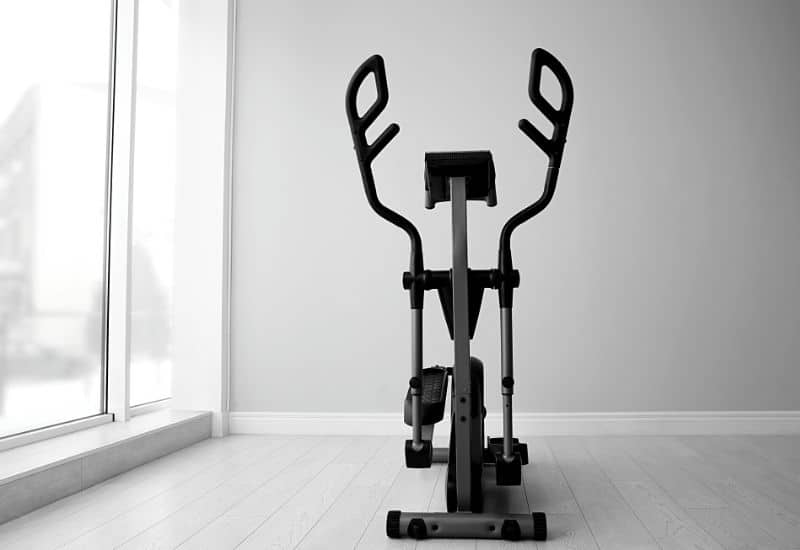
Minute 6-10: Squeeze your core. Every minute, on the minute, focus on engaging your core muscles and really squeezing them as hard as you can. Aim for 15 seconds at first, working your way up to 20, 25, and 30 seconds. The goal is to tense your core muscles for 30 to 45 seconds out of every minute, with the rest of that minute to relax the muscles and let them recover.
Minute 11-15: Hammer your quads. Try this on for size: grip the elliptical’s stationary handles and walk in a squat for a count of 10 to 15, as many as you can sustain before your legs feel like they’re on fire. Give yourself 60 to 90 seconds to rest, then do it all over again. Fit as many squat-walks into the 5-minute period as possible.
Minute 16-20: Reverse and squeeze your core. Stop striding forward (your natural stride), and reverse directions so you’re striding backward. It will take a few minutes to get used to the change of direction, so pay attention to your form and posture until it’s comfortable. After that, spend the rest of the time squeezing your core and really engaging your abs, obliques, and lower back muscles in the same pattern done during Minute 6-10.
Minute 21-25: Squat walk once more. Your quads are the largest muscle group in your lower body, so they can take a lot of hammering. It’s worth paying them a lot of attention, especially when walking in reverse. The movement will train the lower quads that support your knees, making your knees more resilient and less prone to injuries.
Minute 26-30: Target your glutes. Raise the incline to the max, and add a bit of resistance. Doing so will not only target your glutes (with a bit more focus on your hamstrings, too), but make every step feel like a greater effort. Keep working at a normal speed but with max incline until the 30-minute mark.
Cool down. Finish off your workout at a slow, steady pace, with the incline and resistance set to 0. Your muscles have worked hard, and they deserve a “rest” period to recover before you get on with the rest of your day.
Workout #3: LISS Rowing Session
Sometimes, you just want to keep the workouts simple and sweet, without constantly changing up the intensity, resistance, or incline.
This rowing machine workout is just what you need on a day like that!
Once you find your speed, you’ll maintain it for the entire workout session—no speeding up or slowing down.
It’s easy to get lost in the rhythm of the training, and you’ll find that time may just fly by.
For this workout:
Warm up for 5 minutes – Spend the first 5 minutes rowing at a “light” intensity. You should feel your body getting warm, your cardiovascular exertion increasing slightly, and a bit of sweat forming. However, focus on smooth, efficient movements without pushing the pace hard.
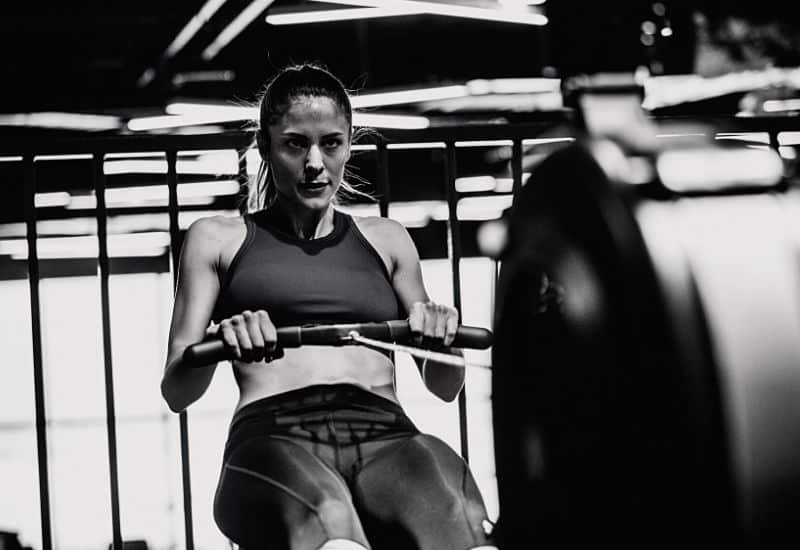
Spend 25 minutes at a “moderate” pace – Use a heart rate monitor watch, smartwatch, or the rowing machine’s built-in heart rate monitor to keep track of your BPM. Your goal should be to keep your heart rate within the 60 to 70% range.
Once you’ve gotten it up to around 65%, keep that as your pace for the next 25 minutes. You should be able to maintain this particular level of exertion with minimal difficulty because your body is able to absorb enough oxygen to burn fat for energy.
Cool down with a walk – Once you’re done with the rowing workout, spend 5-10 minutes walking for active recovery, either on the treadmill or simply walking outside for a cool-down walk. Walking will help to stretch out your spine and prevent lower back pain (a common after-effect of rowing).
See also: 5 Rowing Machine HIIT Workouts (for Beginners, Athletes, and Advanced Users)
Beginner Tips for Cardio Training
If you’re hitting the gym for your first cardio training sessions, here are a few tips to keep in mind:
⭐ Start off slow. Be gentle on your body. In the beginning, it will feel all the aches and pains because it’s not accustomed to so much high-impact exercise and repeated movements. Take it easy on your body and give it time to get used to the cardio training. A slower pace for your first few workouts will make it much easier to get to the faster-paced sessions down the line.
⭐ Always warm up and cool down. This is absolutely imperative! Not only will it help your cardiovascular system to work more efficiently, but it’ll also prevent those aches and pains from slowing you down or stopping your workout.
⭐ Push yourself to work harder. Once you’ve gotten accustomed to a certain pace, try to push the pace a bit after a few workouts. You can start off slow and easy, but gradually increase the intensity, incline, resistance, and speed in order to strive for higher fitness.
⭐ Change is good, but so is consistency. Changing up your workouts prevents boredom, so it’s definitely a good way to keep from losing interest in cardio. However, the only way you’ll be able to run more is by running more, the only way you’ll row more is by rowing more, and the only way you can climb more stairs is by climbing more stairs. With cardio, consistency is the key to visible results.
⭐ Track the time. Set weekly goals for you rcardio sessions, with the aim of being able to do 45-minutes of cardio over time. At this point, your RHR (resting heart rate) will begin to decline, indicating better cardiovascular conditioning, which means it will be time to steadily increase the pace. Use your smartphone, a fitness tracker (like an Apple Watch or Garmin), or the gym clock to stay on top of the duration of your cardio sessions.
Beginner Cardio Workouts – FAQs
How long should beginners do cardio?
Ideally, you should spend at least 30 minutes doing low-intensity cardio, or 15-20 minutes of high-intensity (HIIT) cardio.
The goal should be to work toward more exercise—a 60-minute low-intensity session is great for improving your ability to jog, cycle, or row—but initially, take it easy and start off with a bit less to give your body time to adapt to the exertion.
Is 10 minutes of cardio enough for beginners?
If you’re just starting out and have never run, cycled, rowed, or climbed stairs before, then yes, 10 minutes is enough to get your body accustomed to the exertion.
However, within a few weeks, your goal should be to at least double that amount. Your body should adapt to the exercise enough that you can quickly do more exercise.
The Bottom Line
A good cardio workout is always a solid investment of your time, as it expands your cardiovascular function, enables your body absorb and utilize oxygen more effectively, and translates into better fitness across all your activities of daily life.
Beginners will find the information above helps them to get into cardio easily, and as you’ll soon discover, repeated training is the key to improving your conditioning across the board.
Take one of the beginner workouts above for a spin the next time you hit the gym, and get that cardio going!
More Articles and Guides Like This
The 6 Best Cardio Machines for Weight Loss (And How to Use Them For Best Results). Looking to turbocharge your weight loss in the gym? Here’s a look at the best cardio machines for losing weight, including how many calories each machine burns.